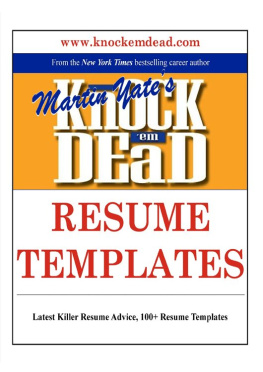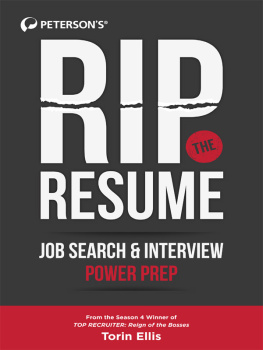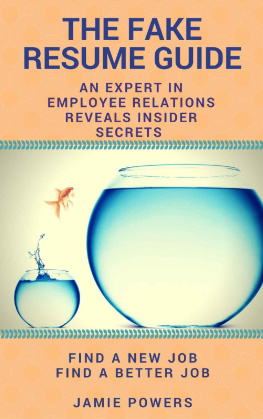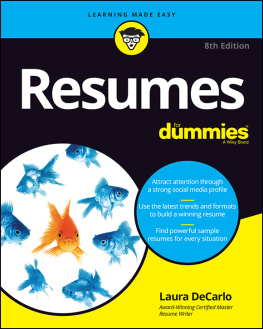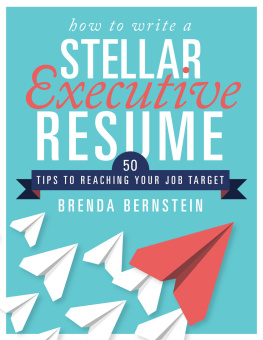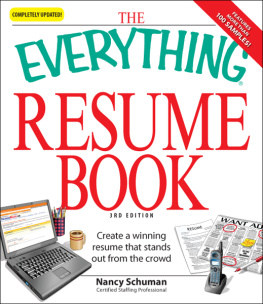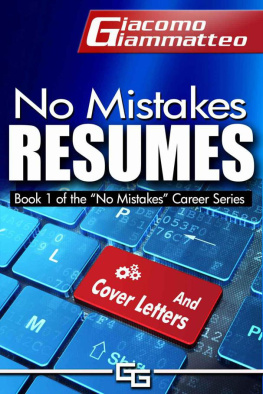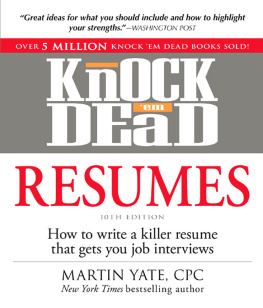Getting Back in the Game
How to Build Your Resume After Taking a Break
Heather Rothbauer-Wanish
Wise Ink Creative Publishing
Minneapolis
GETTING BACK IN THE GAME copyright 2014 by Heather Rothbauer-Wanish. All rights reserved. No part of this book may be reproduced in any form whatsoever, by photography or xerography or by any other means, by broadcast or transmission, by translation into any kind of language, nor by recording electronically or otherwise, without permission in writing from the author, except by a reviewer, who may quote brief passages in critical articles or reviews.
ISBN 13: 978-1-940014-91-3
E-book created by Wise Ink Creative Publishing
Wise Ink Creative Publishing
Minneapolis, Minnesota
www.wiseinkpub.com
Contents
Its an exciting time in your life! You have decided to leap back into the workforce. The next part of the process is the part that many people dreadwriting a resume, creating a cover letter, and going on an interview. This book is designed to help you with all three parts of the process.
First, you will learn how to write a compelling, eye-catching, and captivating resume that truly describes you as a person and potential employee. Next, we will explore cover letters and how they can help sell you. And, lastly, this book will provide tips for interview questions, answers, and techniques.
Through tips, suggestions, and examples, I hope to assist you in your job search process. Above all, it is my goal to provide you with confidence in your abilities and an understanding that Getting Back in the Game doesnt have to be scary. Lets get started!
1
Preparing to Write Your Resume
Preparing to write a resume after being out of the workforce for awhile can be challenging. After writing customized resumes and cover letters for hundreds of individuals, there is one thing I have found. No two clients are exactly the same. And, they shouldnt be after all, this is the clients personal resume with individual information. Another big difference among all of my clients? The level of preparation varies greatly. With a few simple steps, preparing to write your resume doesnt have to be a dreaded process. Organization is the key.
First, keep any job descriptions and job duties lists from previous jobs. When you are struggling to define exactly what you did in a previous position, these job descriptions can be very helpful. They tend to trigger your memory for key duties, responsibilities, and position goals.
Next, maintain a file with transcripts from your educational institutions. Most potential employers only require an unofficial transcript when applying for a position. However, many employers will require an official transcript upon hire or within a certain probationary period. For your transcripts, I recommend keeping both an unofficial copy and an official copy at all times. If you have little professional experience, a transcript is a great way to find classes and other items you can place on the educational portion of your resume.
Finally, keep your letters of recommendation and reference listing close by when writing your resume. Letters of recommendation showcase your skills and abilities, areas that can be highlighted on your resume. And, consider what your references may say about you when a potential employer contacts him or her. Use these words as key words or phrases throughout your newly-created resume.
When it comes to your resume, I recommend keeping more information than necessary. This makes it much easier when trying to gather enough information to craft a well-written resume. And, as you work to create a dynamic document, being organized will only ease the stress associated with the process.
2
Chronological Resumes versus Functional Resumes
Once you have decided to write or update your resume, the next decision involves the format type. Do you want to use a chronological order or a more functional approach? For most people, the chronological resume is the one they were taught. The newest jobs are listed first and previous jobs are listed in reverse chronological order.
Functional resumes group information by tasks accomplished. For example, if you have worked in sales at your previous four jobs, you could group information into sections such as: Sales Management Techniques, Sales Training Experience, and Sales Accomplishments. Writing down your tasks and sorting them according to categories helps you group the functions appropriately.
How do you know when to use a functional resume approach or a chronological resume? Read below to discover which resume type works best for particular situations.
Functional is best when
- The candidate has had many jobs in a short amount of time
- Several jobs have involved the same tasks or responsibilities
- There is a time gap in employment
Chronological is best when
- There are few jobs with little to no time gaps
- Candidate has worked in only one or two career fields
- Career progression is easy to follow
Resume format is something that is always discussed with resume clients at Feather Communications. Each format type has its own advantages and disadvantages. Sometimes it may be appropriate to use a combination of chronological or functional formats. No matter the resume format choice, be sure it appropriately depicts your skills, abilities, qualifications, and professional experience. After all, the goal of the resume is to get your name in front of the potential employer and land an interview.
3
Functional Resumes The Details
If you have been out of work for awhile and are just returning to the workforce, you may wish to minimize the length of time you were not employed. While it is not possible to hide this information, it is possible to place less emphasis on it. And, as stated in the previous chapter, it may be worthwhile to explore a functional resume.
Today, I find that some clients have had five to ten jobs during the last three years. When this is the case, a chronological resume can make someone look like a job hopper. Given the current economic state, more and more people have been forced to switch jobs frequently or have been laid off from previous positions. The question is, how can you make your resume information still stand out and show your skills?
Rather than focus on dates and timing, a functional resume concentrates on your overall skills. Instead of listing jobs in order, decide your two or three areas of expertise and divide your resume into these sections. Example sections could include customer service, accounting experience, and sales accomplishments.
A functional resume can also work well when you have past positions that are not directly related to the position for which you are applying. For example, perhaps you have only one accounting-related job to add to your resume, but you have had previous sales positions. In this case, you could emphasize your customer service, communication, and sales expertise in the Additional Professional Experience section. This does not discount these positions; rather, it shows you learned skills that are still applicable to the potential position.
Finally, a functional resume still lists the jobs that were held, but it doesnt emphasize dates; it can merely showcase the name of the employer and/or the name of the position held. This section can just be called Work Experience. Or, this information can be included in the same section as the Professional Experience or Professional Expertise.


